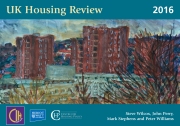
UK HOUSING REVIEW 2016

INTRODUCTION
| PAST EDITION |
| 2016 |
| ACKNOWLEDGEMENTS |
| INTRODUCTION |
| COMMENTARY |
| COMPENDIUM |
| ALL EDITIONS |
| 2025 |
| 2024 |
| 2023 |
| 2022 |
| 2021 |
| 2020 |
| 2019 |
| 2018 |
| 2017 |
| 2016 |
| 2015 |
| 2014 |
| 2013 |
| 2011/12 |
| 2010/11 |
| 2009/10 |
| 2008/9 |
| 2007/8 |
| 2006/7 |
| 2005/6 |
| 2004/5 |
| 2003/4 |
| < 2003 |
| CONTEMPORARY ISSUES |
| UKHR HOME |
| CONTACT |
The 24th edition of the UK Housing Review aims, as with previous editions, to draw together key current financial and related data about both public and private housing in the United Kingdom, and rapidly assemble them in a coherent and accessible format.
As this edition coincides with the 100th anniversary of the Chartered Institute of Housing, this Introduction is followed by a brief appraisal of CIH's history - download here. Sadly, the original plan was to ask Alan Holmans, the doyenne of housing statistics, to contribute a chapter to mark the anniversary, but he died just one year ago. The editors' and contributors' tribute to him, which first appeared in the UK Housing Review June Briefing last year, is reproduced at the end of this edition.
The Review draws on a wide range of expenditure plans and departmental reports, as well as official or other statistical volumes, survey reports, web portals and publications based on specific research projects. The Review also includes a number of tables constructed from databases that are not routinely published elsewhere. Last year's edition included for the first time a complete list of post-war housing ministers in England. The current version of the roll-call appears inside the front cover.
The structure of the Review, and its sparse text, aim above all to provide a swift guide to the data, with wider and more detailed analysis confined to the Section 1: Contemporary Issues chapters at the beginning of the Review. This year the issues chapters focus on the radical changes to the social housing sector in England, the growing impact of welfare reform across the UK, and the evolution of devolved government in Scotland, Wales and Northern Ireland.
The six chapters of Section 2: Commentary offer a brief introduction to and discussion of the key developments in policy, financial provision and outputs, that are reflected in the tables and figures in the main Compendium of Tables. They also provide a reference to other publications and data offering further useful insights into current policy issues. Of this year's six Commentary Chapters, Mark Stephens wrote Chapters 1 and 6, Steve Wilcox wrote Chapter 2, Peter Williams wrote Chapter 3 and John Perry wrote Chapters 4 and 5.
A longer perspective
Many of the tables in the Review provide data over a long time-series. Wherever possible those tables start in 1970, providing data at five-year intervals for the years to 1995, 2000 or 2005, with annual data for more recent years. The precise range of the years covered varies from table to table, depending both on data availability and the practicality of setting out data on a single page. Even with its landscape format, there are limits to the number of years' data that the Review can fit onto a single page.
In some form, most of the tables in this year's volume have been carried in previous editions, and readers can consult back copies for data for the individual years between 1981 and 1995-2005 that are no longer published. However, readers should exercise care as in some cases data for those earlier years may subsequently have been revised, primarily as a result of changes in definitions. A cross-check of the data for those years still published in the current edition of the Review will generally indicate whether or not this is an issue. In this edition a number of existing tables have been restructured, and a few old tables that have not been updated for some years have been omitted.
Regions
The Review contains several tables providing data for the regions of England. Many of those tables provide data for the long-established standard statistical regions (SSRs). For some time, however, government statistics have been published primarily on the basis of (the former) government office regions (GORs). This presents difficulties in providing a consistent long run of regional data.
Wherever possible, current data for standard regions have been sought, in order to provide a consistent data series. This has not, however, always been possible; equally long back-series of data for government office regions are not always available. In some cases, therefore, the Review includes recent data for GORs, together with earlier data for SSRs. This is clearly indicated in the tables concerned. It should also be noted that the former Merseyside region was some time ago incorporated within the North West.
There have been changes in the nomenclature of government office regions in the past; they are now generally shown in the Review under their current names. However, these names are not always used in our source documents or datasets, and we have followed the practice in the latest editions of our sources, rather than impose a uniform usage.
One further point to be noted on English regional housing statistics is that, with the idiosyncratic 2011 DCLG decision to cease inclusion of such figures within its own official statistics, their continued compilation and inclusion (where possible) in the Review has become even more valuable.
Government departments
Over the course of time, government departments are restructured or simply change their name. Thus over the years of the Review's publication the department responsible for housing policy in England has evolved from the Department of the Environment, through the Department of the Environment, Transport and the Regions, the Office of the Deputy Prime Minister, to now being the Department for Communities and Local Government.
Where data series have been made available continuously over that period, the reference given for that data in the tables of the Review is the current form and name of the responsible department. Where, however, reference is made to historical data the reference will be to the form and name of the responsible department at the time they were initially published or otherwise made available to the Review.
The UK Housing Review website
The whole body of tables in the Review, together with the Commentary Chapters (but not the Contemporary Issues articles), are available on the Review's website (www.ukhousingreview.org.uk).
Comments and suggestions
Finally, the editors would welcome any comments or suggestions on the current and future format and contents of the Review, and they can be contacted by email, phone or letter - see Acknowledgements.







© UK Housing Review | Cookie Policy | CIH Privacy Policy